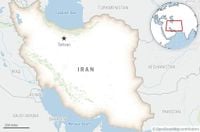On a humid Monday night in late September 2025, a U.S.-chartered plane quietly departed from Louisiana, its destination set for Qatar, and ultimately, Tehran. Onboard were about 100 Iranians—men and women facing forced return to their homeland under a new, sweeping U.S. immigration initiative that has stunned advocates, drawn international scrutiny, and marked an unexpected moment of cooperation between two nations typically at loggerheads.
According to The New York Times and multiple international outlets, this flight was just the first in a series of deportation operations expected to remove as many as 400 Iranian nationals from the United States in the coming weeks. The deportees, U.S. and Iranian officials confirmed, were largely those who had entered the country illegally—many crossing the border from Mexico—or who faced other immigration violations, including some with criminal convictions. For most, their bids for asylum had already been denied, or they hadn’t yet had the chance to plead their case before a judge.
Hossein Noushabadi, director general for parliamentary and consular affairs at Iran’s Foreign Ministry, told the semi-official Tasnim news agency on Tuesday, September 30, “In the first phase, they decided to deport 120 Iranians who entered the U.S. illegally, most of whom through Mexico.” He added that the first group was expected to arrive in Iran “within the next one or two days” after a stopover in Qatar. Qatari authorities, for their part, declined to comment on the specifics of the transfer.
The scale of this operation is historic. In the 2024 fiscal year, U.S. Immigration and Customs Enforcement deported just 20 Iranians. Now, with President Donald Trump’s renewed crackdown on illegal immigration, the number is set to surge dramatically. The White House, in a statement through spokeswoman Abigail Jackson, declared, “The Trump Administration is committed to fulfilling President Trump’s promise to carry out the largest mass deportation operation of illegal aliens in history, using all the tools at our disposal.”
Yet, the context is as fraught as the numbers are stark. The deportations come on the heels of a tense summer, during which the U.S., in concert with Israel, bombed Iranian nuclear sites in a 12-day conflict. The reverberations of those strikes still echo in the halls of diplomacy. Iran’s Foreign Minister Abbas Araghchi and President Masoud Pezeshkian had only recently returned from a last-ditch effort at the U.N. General Assembly to stave off reimposed sanctions. Their attempts were rebuffed by Iran’s supreme leader, Ayatollah Ali Khamenei, who dismissed further negotiations with Washington as futile. “With Americans, both directly and indirectly, messages were exchanged, and eventually, we are relieved that we did whatever it was necessary,” Araghchi said on Iranian state TV, while also conceding, “It was clear and evident to us after the interpretation the Supreme Leader made that negotiations with Americans is an obvious dead-end.”
Despite the tensions, the deportations represent a rare and uneasy moment of bilateral cooperation. Iranian officials, however, have publicly downplayed the idea of a political deal, describing the matter as purely consular. As one unnamed Iranian official told Reuters, “The matter was consular, not political.” Still, The New York Times reported that the deportations were “the culmination of months of discussions between the two countries.”
For the deportees themselves, the situation is dire. Many have spent months in U.S. detention centers, facing what advocates describe as “deplorable treatment.” Jamal Abdi, president of the National Iranian American Council, warned, “The fact that a deportation flight is being chartered to Iran underscores the grave civil rights violations being inflicted on Iranian nationals here in the United States.” He added, “Our understanding is all these individuals agreed to be deported to Iran when facing a terrible choice: endure deplorable treatment in some of the worst prison conditions in the United States with little hope for release, be deported to a third country where they don’t speak the language, or return to Iran.”
Indeed, at least 16 people have died in U.S. immigration detention since the beginning of 2025, putting this year on track to be among the deadliest for in-custody deaths in decades, according to reporting by The Independent. The United Nations refugee agency, UNHCR, was not consulted on the deportations and issued a pointed reminder: “In general terms, States must ensure access to asylum, due process, and respect for the principle of non-refoulement, meaning that people in need of international protection must not be returned to a place where they face risk of harm.”
Some of those being sent back to Iran had previously been granted residence permits in the U.S. but were included on the deportation list for reasons not fully explained by authorities. Noushabadi clarified, “Some (returnees) had residence permits but due to reasons stated by the U.S. immigration office they were included in the list. Of course, their own consent was obtained for their return.” Still, not all departures were voluntary. The New York Times found that while some Iranians agreed to leave after months of detention, others did not, raising questions about the true voluntariness of these removals.
The Trump administration’s broader immigration policies have come under heavy fire from human rights groups and international observers. The U.S. has faced ongoing criticism for deporting individuals to countries with poor human rights records, or to so-called “third party” nations where they have no ties and may face grave danger. Past deportations have sent Venezuelan migrants to harsh prisons in El Salvador, and others to conflict-ridden nations like Libya and South Sudan.
For Iranians in the U.S., the changing landscape is especially jarring. Since the 1979 Islamic Revolution, the U.S. had often welcomed Iranian dissidents, exiles, and others fleeing persecution. In recent years, U.S. authorities arrested 1,710 Iranians crossing the border illegally from Mexico between September 2021 and November 2024, with 130 arrests in October 2024 alone. Iranians have historically had a relatively high asylum approval rate—41% compared to 25% for all nationalities—according to the Transactional Records Access Clearinghouse. But the new mass deportations signal a sharp departure from past practice.
As the first planeload of deportees prepares to land in Tehran, the fate of those returning remains uncertain. Iran’s record on human rights is poor, and advocates fear many could face persecution. The U.S. government, meanwhile, appears committed to its new course. Whether this rare moment of cooperation between Washington and Tehran will last—or what it will mean for the lives of those caught in between—remains to be seen.






